roof FORD EXCURSION 2002 1.G Owners Manual
[x] Cancel search | Manufacturer: FORD, Model Year: 2002, Model line: EXCURSION, Model: FORD EXCURSION 2002 1.GPages: 272, PDF Size: 5.06 MB
Page 103 of 272
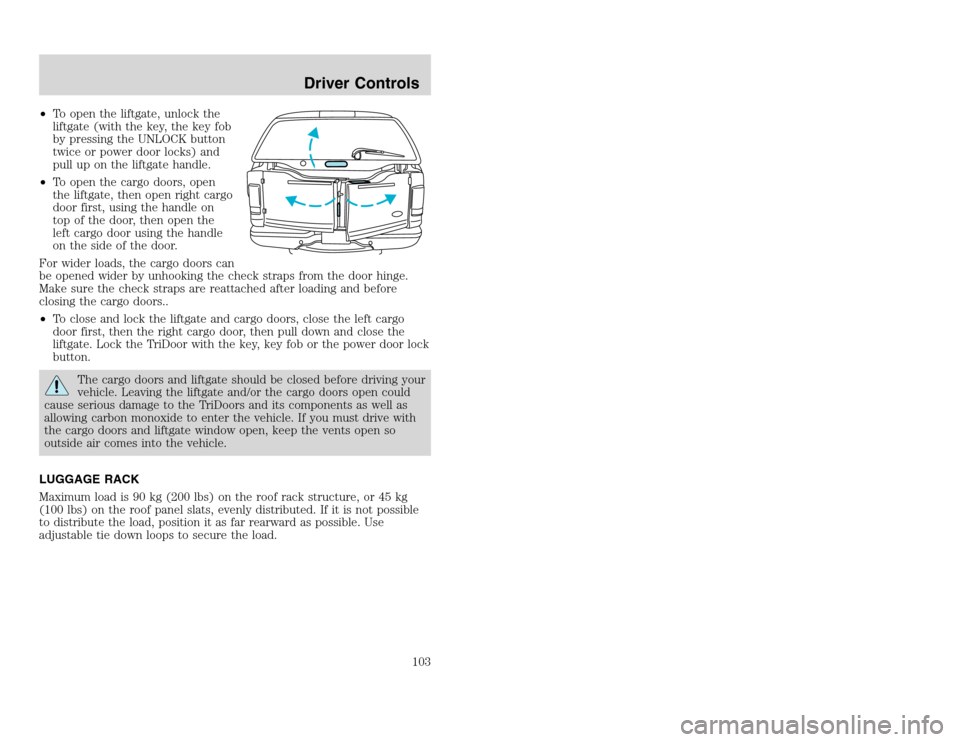
20815.psp Ford O/G 2002 Excursion English 4th Print 2C3J-19A321-HB 04/24/2003 09:14:57 52 A
•To open the liftgate, unlock the
liftgate (with the key, the key fob
by pressing the UNLOCK button
twice or power door locks) and
pull up on the liftgate handle.
•To open the cargo doors, open
the liftgate, then open right cargo
door first, using the handle on
top of the door, then open the
left cargo door using the handle
on the side of the door.
For wider loads, the cargo doors can
be opened wider by unhooking the check straps from the door hinge.
Make sure the check straps are reattached after loading and before
closing the cargo doors..
•To close and lock the liftgate and cargo doors, close the left cargo
door first, then the right cargo door, then pull down and close the
liftgate. Lock the TriDoor with the key, key fob or the power door lock
button.
The cargo doors and liftgate should be closed before driving your
vehicle. Leaving the liftgate and/or the cargo doors open could
cause serious damage to the TriDoors and its components as well as
allowing carbon monoxide to enter the vehicle. If you must drive with
the cargo doors and liftgate window open, keep the vents open so
outside air comes into the vehicle.
LUGGAGE RACK
Maximum load is 90 kg (200 lbs) on the roof rack structure, or 45 kg
(100 lbs) on the roof panel slats, evenly distributed. If it is not possible
to distribute the load, position it as far rearward as possible. Use
adjustable tie down loops to secure the load.
Driver Controls
103
•To open the liftgate, unlock the
liftgate (with the key, the key fob
by pressing the UNLOCK button
twice or power door locks) and
pull up on the liftgate handle.
•To open the cargo doors, open
the liftgate, then open right cargo
door first, using the handle on
top of the door, then open the
left cargo door using the handle
on the side of the door.
For wider loads, the cargo doors can
be opened wider by unhooking the check straps from the door hinge.
Make sure the check straps are reattached after loading and before
closing the cargo doors..
•To close and lock the liftgate and cargo doors, close the left cargo
door first, then the right cargo door, then pull down and close the
liftgate. Lock the TriDoor with the key, key fob or the power door lock
button.
The cargo doors and liftgate should be closed before driving your
vehicle. Leaving the liftgate and/or the cargo doors open could
cause serious damage to the TriDoors and its components as well as
allowing carbon monoxide to enter the vehicle. If you must drive with
the cargo doors and liftgate window open, keep the vents open so
outside air comes into the vehicle.
LUGGAGE RACK
Maximum load is 90 kg (200 lbs) on the roof rack structure, or 45 kg
(100 lbs) on the roof panel slats, evenly distributed. If it is not possible
to distribute the load, position it as far rearward as possible. Use
adjustable tie down loops to secure the load.
Driver Controls
103
Page 104 of 272
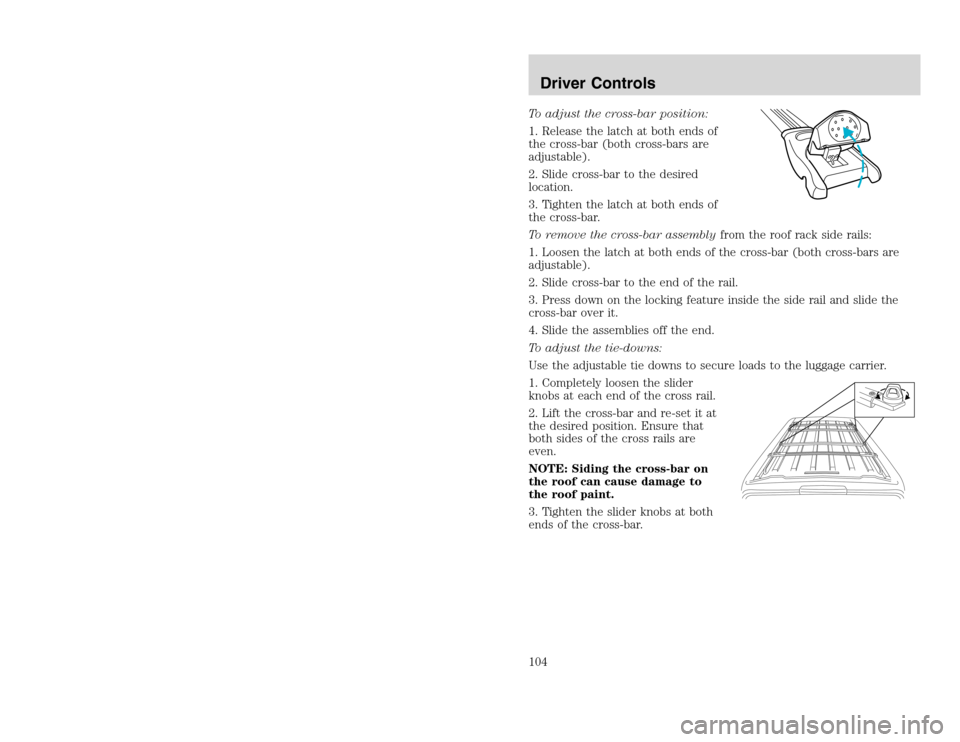
20815.psp Ford O/G 2002 Excursion English 4th Print 2C3J-19A321-HB 04/24/2003 09:14:57 52 B
To adjust the cross-bar position:
1. Release the latch at both ends of
the cross-bar (both cross-bars are
adjustable).
2. Slide cross-bar to the desired
location.
3. Tighten the latch at both ends of
the cross-bar.
To remove the cross-bar assemblyfrom the roof rack side rails:
1. Loosen the latch at both ends of the cross-bar (both cross-bars are
adjustable).
2. Slide cross-bar to the end of the rail.
3. Press down on the locking feature inside the side rail and slide the
cross-bar over it.
4. Slide the assemblies off the end.
To adjust the tie-downs:
Use the adjustable tie downs to secure loads to the luggage carrier.
1. Completely loosen the slider
knobs at each end of the cross rail.
2. Lift the cross-bar and re-set it at
the desired position. Ensure that
both sides of the cross rails are
even.
NOTE: Siding the cross-bar on
the roof can cause damage to
the roof paint.
3. Tighten the slider knobs at both
ends of the cross-bar.Driver Controls104
To adjust the cross-bar position:
1. Release the latch at both ends of
the cross-bar (both cross-bars are
adjustable).
2. Slide cross-bar to the desired
location.
3. Tighten the latch at both ends of
the cross-bar.
To remove the cross-bar assemblyfrom the roof rack side rails:
1. Loosen the latch at both ends of the cross-bar (both cross-bars are
adjustable).
2. Slide cross-bar to the end of the rail.
3. Press down on the locking feature inside the side rail and slide the
cross-bar over it.
4. Slide the assemblies off the end.
To adjust the tie-downs:
Use the adjustable tie downs to secure loads to the luggage carrier.
1. Completely loosen the slider
knobs at each end of the cross rail.
2. Lift the cross-bar and re-set it at
the desired position. Ensure that
both sides of the cross rails are
even.
NOTE: Siding the cross-bar on
the roof can cause damage to
the roof paint.
3. Tighten the slider knobs at both
ends of the cross-bar.Driver Controls104
Page 106 of 272
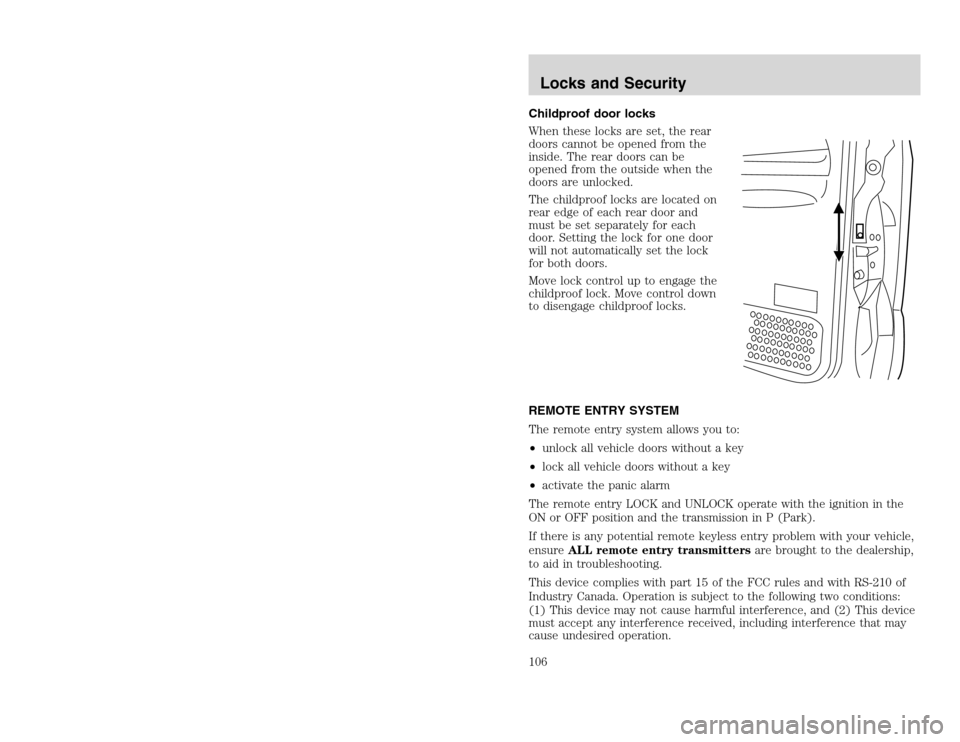
20815.psp Ford O/G 2002 Excursion English 4th Print 2C3J-19A321-HB 04/24/2003 09:14:57 53 B
Childproof door locks
When these locks are set, the rear
doors cannot be opened from the
inside. The rear doors can be
opened from the outside when the
doors are unlocked.
The childproof locks are located on
rear edge of each rear door and
must be set separately for each
door. Setting the lock for one door
will not automatically set the lock
for both doors.
Move lock control up to engage the
childproof lock. Move control down
to disengage childproof locks.
REMOTE ENTRY SYSTEM
The remote entry system allows you to:
•unlock all vehicle doors without a key
•lock all vehicle doors without a key
•activate the panic alarm
The remote entry LOCK and UNLOCK operate with the ignition in the
ON or OFF position and the transmission in P (Park).
If there is any potential remote keyless entry problem with your vehicle,
ensureALL remote entry transmittersare brought to the dealership,
to aid in troubleshooting.
This device complies with part 15 of the FCC rules and with RS-210 of
Industry Canada. Operation is subject to the following two conditions:
(1) This device may not cause harmful interference, and (2) This device
must accept any interference received, including interference that may
cause undesired operation.Locks and Security106
Childproof door locks
When these locks are set, the rear
doors cannot be opened from the
inside. The rear doors can be
opened from the outside when the
doors are unlocked.
The childproof locks are located on
rear edge of each rear door and
must be set separately for each
door. Setting the lock for one door
will not automatically set the lock
for both doors.
Move lock control up to engage the
childproof lock. Move control down
to disengage childproof locks.
REMOTE ENTRY SYSTEM
The remote entry system allows you to:
•unlock all vehicle doors without a key
•lock all vehicle doors without a key
•activate the panic alarm
The remote entry LOCK and UNLOCK operate with the ignition in the
ON or OFF position and the transmission in P (Park).
If there is any potential remote keyless entry problem with your vehicle,
ensureALL remote entry transmittersare brought to the dealership,
to aid in troubleshooting.
This device complies with part 15 of the FCC rules and with RS-210 of
Industry Canada. Operation is subject to the following two conditions:
(1) This device may not cause harmful interference, and (2) This device
must accept any interference received, including interference that may
cause undesired operation.Locks and Security106
Page 213 of 272
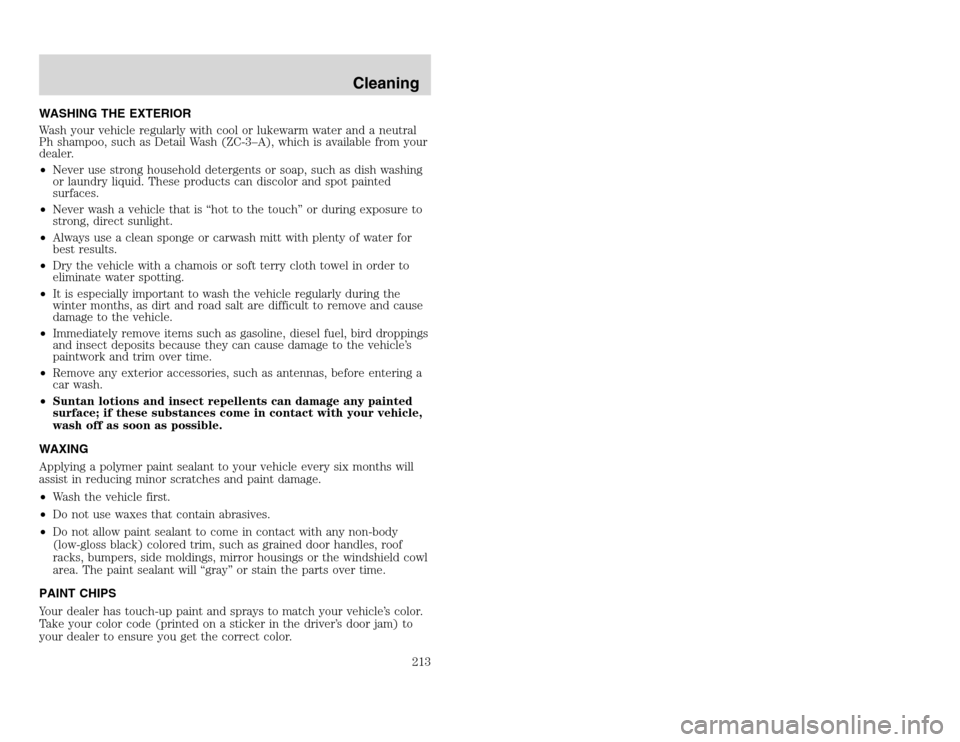
20815.psp Ford O/G 2002 Excursion English 4th Print 2C3J-19A321-HB 04/24/2003 09:14:57 107 A
WASHING THE EXTERIOR
Wash your vehicle regularly with cool or lukewarm water and a neutral
Ph shampoo, such as Detail Wash (ZC-3–A), which is available from your
dealer.
•Never use strong household detergents or soap, such as dish washing
or laundry liquid. These products can discolor and spot painted
surfaces.
•Never wash a vehicle that is “hot to the touch” or during exposure to
strong, direct sunlight.
•Always use a clean sponge or carwash mitt with plenty of water for
best results.
•Dry the vehicle with a chamois or soft terry cloth towel in order to
eliminate water spotting.
•It is especially important to wash the vehicle regularly during the
winter months, as dirt and road salt are difficult to remove and cause
damage to the vehicle.
•Immediately remove items such as gasoline, diesel fuel, bird droppings
and insect deposits because they can cause damage to the vehicle’s
paintwork and trim over time.
•Remove any exterior accessories, such as antennas, before entering a
car wash.
•Suntan lotions and insect repellents can damage any painted
surface; if these substances come in contact with your vehicle,
wash off as soon as possible.
WAXING
Applying a polymer paint sealant to your vehicle every six months will
assist in reducing minor scratches and paint damage.
•Wash the vehicle first.
•Do not use waxes that contain abrasives.
•Do not allow paint sealant to come in contact with any non-body
(low-gloss black) colored trim, such as grained door handles, roof
racks, bumpers, side moldings, mirror housings or the windshield cowl
area. The paint sealant will “gray” or stain the parts over time.
PAINT CHIPS
Your dealer has touch-up paint and sprays to match your vehicle’s color.
Take your color code (printed on a sticker in the driver’s door jam) to
your dealer to ensure you get the correct color.
Cleaning
213
WASHING THE EXTERIOR
Wash your vehicle regularly with cool or lukewarm water and a neutral
Ph shampoo, such as Detail Wash (ZC-3–A), which is available from your
dealer.
•Never use strong household detergents or soap, such as dish washing
or laundry liquid. These products can discolor and spot painted
surfaces.
•Never wash a vehicle that is “hot to the touch” or during exposure to
strong, direct sunlight.
•Always use a clean sponge or carwash mitt with plenty of water for
best results.
•Dry the vehicle with a chamois or soft terry cloth towel in order to
eliminate water spotting.
•It is especially important to wash the vehicle regularly during the
winter months, as dirt and road salt are difficult to remove and cause
damage to the vehicle.
•Immediately remove items such as gasoline, diesel fuel, bird droppings
and insect deposits because they can cause damage to the vehicle’s
paintwork and trim over time.
•Remove any exterior accessories, such as antennas, before entering a
car wash.
•Suntan lotions and insect repellents can damage any painted
surface; if these substances come in contact with your vehicle,
wash off as soon as possible.
WAXING
Applying a polymer paint sealant to your vehicle every six months will
assist in reducing minor scratches and paint damage.
•Wash the vehicle first.
•Do not use waxes that contain abrasives.
•Do not allow paint sealant to come in contact with any non-body
(low-gloss black) colored trim, such as grained door handles, roof
racks, bumpers, side moldings, mirror housings or the windshield cowl
area. The paint sealant will “gray” or stain the parts over time.
PAINT CHIPS
Your dealer has touch-up paint and sprays to match your vehicle’s color.
Take your color code (printed on a sticker in the driver’s door jam) to
your dealer to ensure you get the correct color.
Cleaning
213
Page 264 of 272
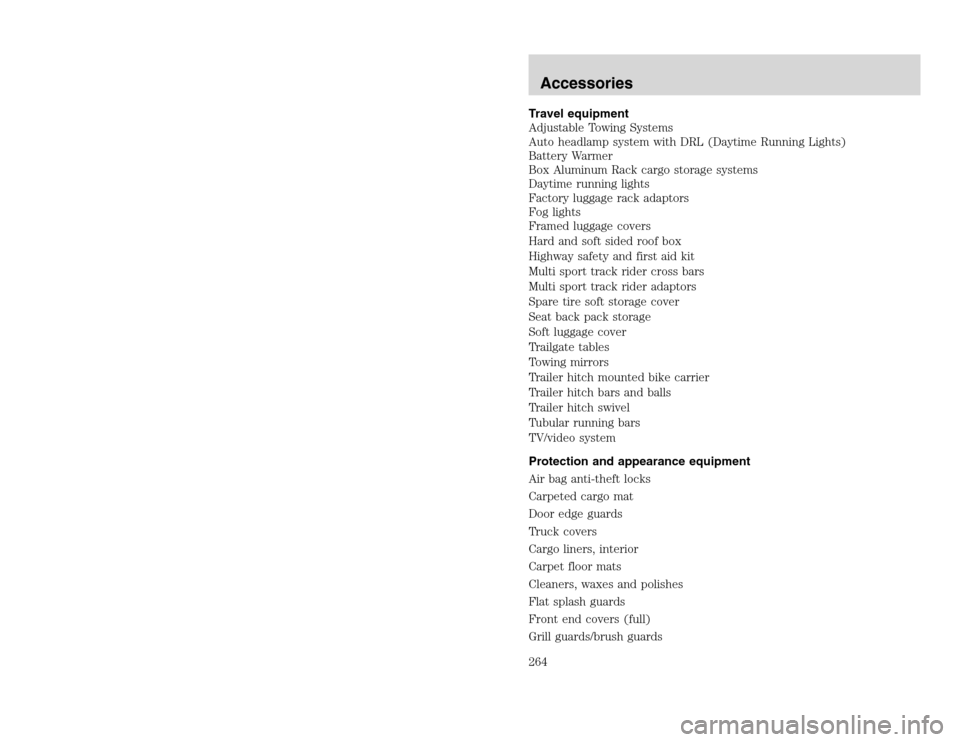
20815.psp Ford O/G 2002 Excursion English 4th Print 2C3J-19A321-HB 04/24/2003 09:14:57 132 B
Travel equipment
Adjustable Towing Systems
Auto headlamp system with DRL (Daytime Running Lights)
Battery Warmer
Box Aluminum Rack cargo storage systems
Daytime running lights
Factory luggage rack adaptors
Fog lights
Framed luggage covers
Hard and soft sided roof box
Highway safety and first aid kit
Multi sport track rider cross bars
Multi sport track rider adaptors
Spare tire soft storage cover
Seat back pack storage
Soft luggage cover
Trailgate tables
Towing mirrors
Trailer hitch mounted bike carrier
Trailer hitch bars and balls
Trailer hitch swivel
Tubular running bars
TV/video system
Protection and appearance equipment
Air bag anti-theft locks
Carpeted cargo mat
Door edge guards
Truck covers
Cargo liners, interior
Carpet floor mats
Cleaners, waxes and polishes
Flat splash guards
Front end covers (full)
Grill guards/brush guardsAccessories264
Travel equipment
Adjustable Towing Systems
Auto headlamp system with DRL (Daytime Running Lights)
Battery Warmer
Box Aluminum Rack cargo storage systems
Daytime running lights
Factory luggage rack adaptors
Fog lights
Framed luggage covers
Hard and soft sided roof box
Highway safety and first aid kit
Multi sport track rider cross bars
Multi sport track rider adaptors
Spare tire soft storage cover
Seat back pack storage
Soft luggage cover
Trailgate tables
Towing mirrors
Trailer hitch mounted bike carrier
Trailer hitch bars and balls
Trailer hitch swivel
Tubular running bars
TV/video system
Protection and appearance equipment
Air bag anti-theft locks
Carpeted cargo mat
Door edge guards
Truck covers
Cargo liners, interior
Carpet floor mats
Cleaners, waxes and polishes
Flat splash guards
Front end covers (full)
Grill guards/brush guardsAccessories264
Page 265 of 272
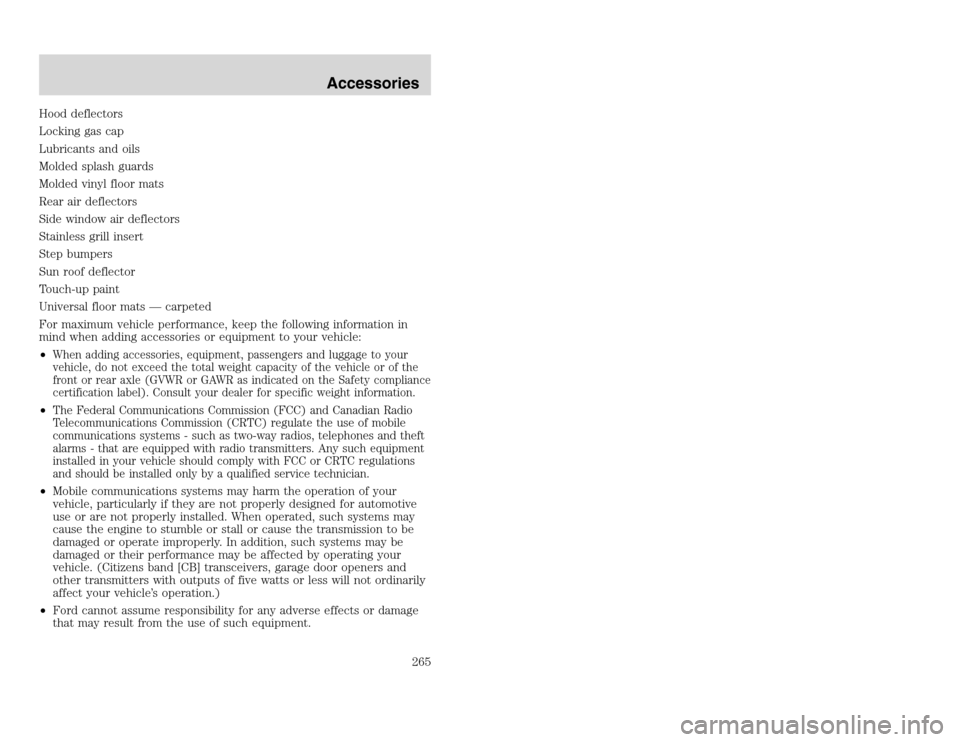
20815.psp Ford O/G 2002 Excursion English 4th Print 2C3J-19A321-HB 04/24/2003 09:14:57 133 A
Hood deflectors
Locking gas cap
Lubricants and oils
Molded splash guards
Molded vinyl floor mats
Rear air deflectors
Side window air deflectors
Stainless grill insert
Step bumpers
Sun roof deflector
Touch-up paint
Universal floor mats — carpeted
For maximum vehicle performance, keep the following information in
mind when adding accessories or equipment to your vehicle:
•
When adding accessories, equipment, passengers and luggage to your
vehicle, do not exceed the total weight capacity of the vehicle or of the
front or rear axle (GVWR or GAWR as indicated on the Safety compliance
certification label). Consult your dealer for specific weight information.
•
The Federal Communications Commission (FCC) and Canadian Radio
Telecommunications Commission (CRTC) regulate the use of mobile
communications systems - such as two-way radios, telephones and theft
alarms - that are equipped with radio transmitters. Any such equipment
installed in your vehicle should comply with FCC or CRTC regulations
and should be installed only by a qualified service technician.
•Mobile communications systems may harm the operation of your
vehicle, particularly if they are not properly designed for automotive
use or are not properly installed. When operated, such systems may
cause the engine to stumble or stall or cause the transmission to be
damaged or operate improperly. In addition, such systems may be
damaged or their performance may be affected by operating your
vehicle. (Citizens band [CB] transceivers, garage door openers and
other transmitters with outputs of five watts or less will not ordinarily
affect your vehicle’s operation.)
•Ford cannot assume responsibility for any adverse effects or damage
that may result from the use of such equipment.
Accessories
265
Hood deflectors
Locking gas cap
Lubricants and oils
Molded splash guards
Molded vinyl floor mats
Rear air deflectors
Side window air deflectors
Stainless grill insert
Step bumpers
Sun roof deflector
Touch-up paint
Universal floor mats — carpeted
For maximum vehicle performance, keep the following information in
mind when adding accessories or equipment to your vehicle:
•
When adding accessories, equipment, passengers and luggage to your
vehicle, do not exceed the total weight capacity of the vehicle or of the
front or rear axle (GVWR or GAWR as indicated on the Safety compliance
certification label). Consult your dealer for specific weight information.
•
The Federal Communications Commission (FCC) and Canadian Radio
Telecommunications Commission (CRTC) regulate the use of mobile
communications systems - such as two-way radios, telephones and theft
alarms - that are equipped with radio transmitters. Any such equipment
installed in your vehicle should comply with FCC or CRTC regulations
and should be installed only by a qualified service technician.
•Mobile communications systems may harm the operation of your
vehicle, particularly if they are not properly designed for automotive
use or are not properly installed. When operated, such systems may
cause the engine to stumble or stall or cause the transmission to be
damaged or operate improperly. In addition, such systems may be
damaged or their performance may be affected by operating your
vehicle. (Citizens band [CB] transceivers, garage door openers and
other transmitters with outputs of five watts or less will not ordinarily
affect your vehicle’s operation.)
•Ford cannot assume responsibility for any adverse effects or damage
that may result from the use of such equipment.
Accessories
265
Page 270 of 272
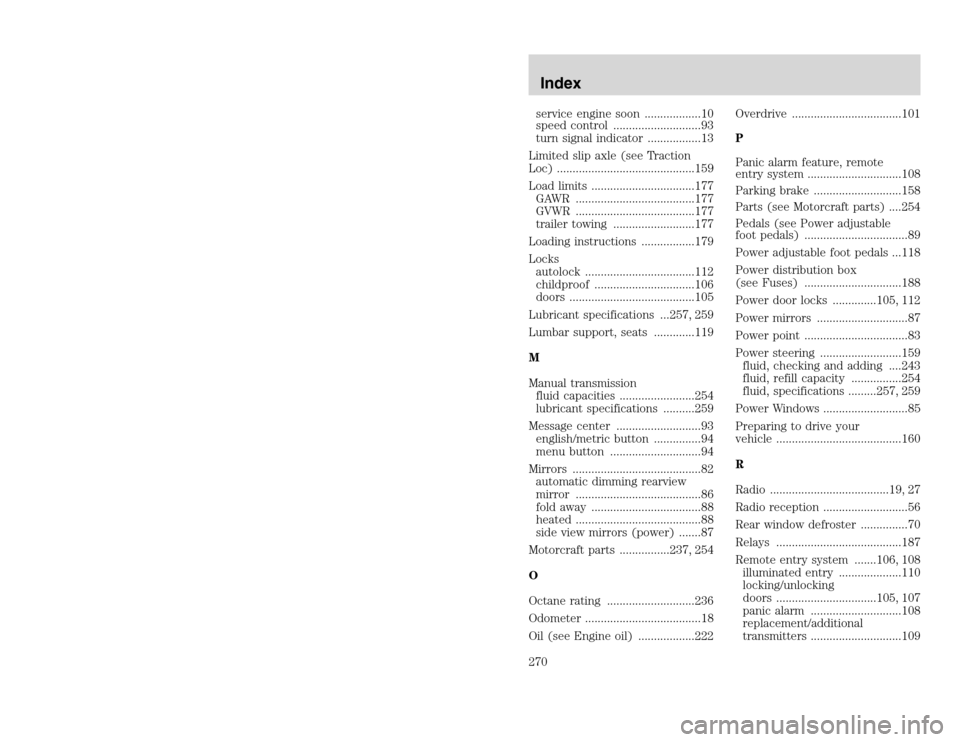
20815.psp Ford O/G 2002 Excursion English 4th Print 2C3J-19A321-HB 04/24/2003 09:14:57 135 B
service engine soon ..................10
speed control ............................93
turn signal indicator .................13
Limited slip axle (see Traction
Loc) ............................................159
Load limits .................................177
GAWR ......................................177
GVWR ......................................177
trailer towing ..........................177
Loading instructions .................179
Locks
autolock ...................................112
childproof ................................106
doors ........................................105
Lubricant specifications ...257, 259
Lumbar support, seats .............119
M
Manual transmission
fluid capacities ........................254
lubricant specifications ..........259
Message center ...........................93
english/metric button ...............94
menu button .............................94
Mirrors .........................................82
automatic dimming rearview
mirror ........................................86
fold away ...................................88
heated ........................................88
side view mirrors (power) .......87
Motorcraft parts ................237, 254
O
Octane rating ............................236
Odometer .....................................18
Oil (see Engine oil) ..................222Overdrive ...................................101
P
Panic alarm feature, remote
entry system ..............................108
Parking brake ............................158
Parts (see Motorcraft parts) ....254
Pedals (see Power adjustable
foot pedals) .................................89
Power adjustable foot pedals ...118
Power distribution box
(see Fuses) ...............................188
Power door locks ..............105, 112
Power mirrors .............................87
Power point .................................83
Power steering ..........................159
fluid, checking and adding ....243
fluid, refill capacity ................254
fluid, specifications .........257, 259
Power Windows ...........................85
Preparing to drive your
vehicle ........................................160
R
Radio ......................................19, 27
Radio reception ...........................56
Rear window defroster ...............70
Relays ........................................187
Remote entry system .......106, 108
illuminated entry ....................110
locking/unlocking
doors ................................105, 107
panic alarm .............................108
replacement/additional
transmitters .............................109Index270
service engine soon ..................10
speed control ............................93
turn signal indicator .................13
Limited slip axle (see Traction
Loc) ............................................159
Load limits .................................177
GAWR ......................................177
GVWR ......................................177
trailer towing ..........................177
Loading instructions .................179
Locks
autolock ...................................112
childproof ................................106
doors ........................................105
Lubricant specifications ...257, 259
Lumbar support, seats .............119
M
Manual transmission
fluid capacities ........................254
lubricant specifications ..........259
Message center ...........................93
english/metric button ...............94
menu button .............................94
Mirrors .........................................82
automatic dimming rearview
mirror ........................................86
fold away ...................................88
heated ........................................88
side view mirrors (power) .......87
Motorcraft parts ................237, 254
O
Octane rating ............................236
Odometer .....................................18
Oil (see Engine oil) ..................222Overdrive ...................................101
P
Panic alarm feature, remote
entry system ..............................108
Parking brake ............................158
Parts (see Motorcraft parts) ....254
Pedals (see Power adjustable
foot pedals) .................................89
Power adjustable foot pedals ...118
Power distribution box
(see Fuses) ...............................188
Power door locks ..............105, 112
Power mirrors .............................87
Power point .................................83
Power steering ..........................159
fluid, checking and adding ....243
fluid, refill capacity ................254
fluid, specifications .........257, 259
Power Windows ...........................85
Preparing to drive your
vehicle ........................................160
R
Radio ......................................19, 27
Radio reception ...........................56
Rear window defroster ...............70
Relays ........................................187
Remote entry system .......106, 108
illuminated entry ....................110
locking/unlocking
doors ................................105, 107
panic alarm .............................108
replacement/additional
transmitters .............................109Index270
Page 271 of 272

20815.psp Ford O/G 2002 Excursion English 4th Print 2C3J-19A321-HB 04/24/2003 09:14:57 136 A
replacing the batteries ...........108
Reverse sensing system ...........164
Roadside assistance ..................185
Roof rack ...................................103
S
Safety belts (see Safety
restraints) ............14, 128–131, 133
Safety defects, reporting ..........212
Safety restraints ........128–131, 133
belt minder .............................135
cleaning the safety belts ........139
extension assembly ................139
for adults .........................129–131
for children .....................144–145
lap belt ....................................134
warning light and
chime ...........................12, 14, 135
Safety seats for children ..........145
Seat belts (see Safety
restraints) ..................................128
Seats ..........................................117
child safety seats ....................145
memory seat ...........................118
SecuriLock passive anti-theft
system ................................113–115
Servicing your vehicle ..............219
Snowplowing .................................7
Spare tire (see Changing the
Tire) ...........................................192
Spark plugs,
specifications .............254, 259–260
Special notice
diesel-powered vehicles .............7
utility-type vehicles ....................7Specification chart,
lubricants ...........................257, 259
Speed control ..............................89
Speedometer ...............................18
Starting your vehicle ........152–154
jump starting ..........................197
Steering .....................................159
Steering wheel
controls ..........................82, 89, 93
tilting .........................................82
T
Tachometer .................................18
Tires ...........................192, 249–251
changing ..........................192–193
checking the pressure ............251
replacing ..................................252
rotating ....................................251
snow tires and chains ............253
tire grades ...............................250
treadwear ................................250
Towing .......................................180
recreational towing .................184
trailer towing ..........................180
wrecker ....................................202
Traction-lok rear axle ...............159
Transfer case
fluid checking .........................247
Transmission .............................160
fluid, checking and adding
(automatic) .............................245
fluid, refill capacities ..............254
lubricant
specifications ..................257, 259
Transmission control indicator
light ..............................................13
Trip odometer .............................18
Index
271
replacing the batteries ...........108
Reverse sensing system ...........164
Roadside assistance ..................185
Roof rack ...................................103
S
Safety belts (see Safety
restraints) ............14, 128–131, 133
Safety defects, reporting ..........212
Safety restraints ........128–131, 133
belt minder .............................135
cleaning the safety belts ........139
extension assembly ................139
for adults .........................129–131
for children .....................144–145
lap belt ....................................134
warning light and
chime ...........................12, 14, 135
Safety seats for children ..........145
Seat belts (see Safety
restraints) ..................................128
Seats ..........................................117
child safety seats ....................145
memory seat ...........................118
SecuriLock passive anti-theft
system ................................113–115
Servicing your vehicle ..............219
Snowplowing .................................7
Spare tire (see Changing the
Tire) ...........................................192
Spark plugs,
specifications .............254, 259–260
Special notice
diesel-powered vehicles .............7
utility-type vehicles ....................7Specification chart,
lubricants ...........................257, 259
Speed control ..............................89
Speedometer ...............................18
Starting your vehicle ........152–154
jump starting ..........................197
Steering .....................................159
Steering wheel
controls ..........................82, 89, 93
tilting .........................................82
T
Tachometer .................................18
Tires ...........................192, 249–251
changing ..........................192–193
checking the pressure ............251
replacing ..................................252
rotating ....................................251
snow tires and chains ............253
tire grades ...............................250
treadwear ................................250
Towing .......................................180
recreational towing .................184
trailer towing ..........................180
wrecker ....................................202
Traction-lok rear axle ...............159
Transfer case
fluid checking .........................247
Transmission .............................160
fluid, checking and adding
(automatic) .............................245
fluid, refill capacities ..............254
lubricant
specifications ..................257, 259
Transmission control indicator
light ..............................................13
Trip odometer .............................18
Index
271